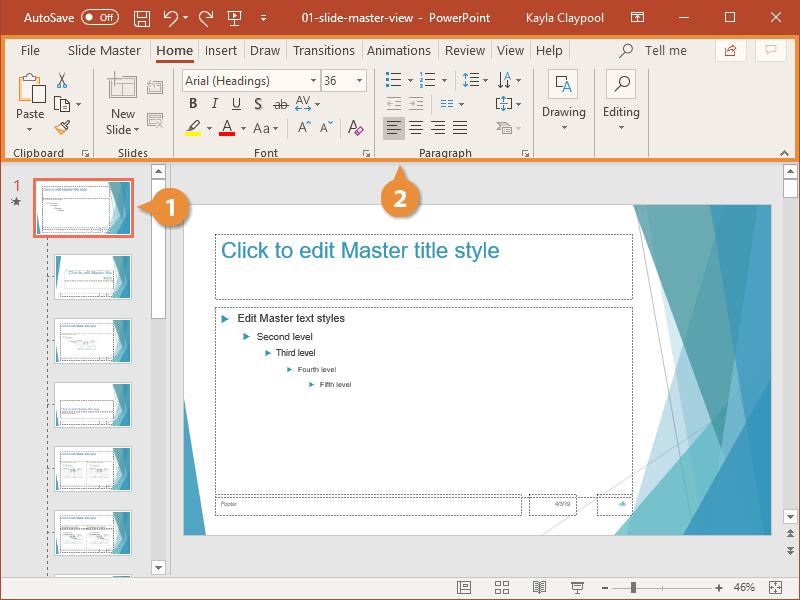

When you modify one or more of the slide layouts beneath a slide master, you are essentially modifying the slide master. However, the majority of your changes will likely be to the slide layouts related to the master. When you edit the slide master, all slides in your presentation that are based on that master will contain your changes. The related slide layouts appear just below the slide master. The master slide is the top slide in the thumbnail pane on the left side of the screen. To get to Slide Master view, on the View tab, click Side Master. When you use a slide master, you save time because you don't have to apply styles on more than one slide. The key benefit to modifying and using slide masters is that you can make universal style changes to all the slides in your presentation, including slides added later.

And if you need to make any formatting tweaks, just make them in the Layout and your slides should automatically update.A slide master is the top slide in a hierarchy of slides that stores information about the theme and slide layouts of a presentation, including the background, color, fonts, effects, placeholder sizes, and positioning.Įvery presentation contains at least one slide master that is created automatically when you open a new presentation. …until we reapply the newly formatted Layout giving us this:Īll paragraphs are still a first-level bullet, but by simply inserting the cursor at a point in the text and using the Increase List Level tool on the Home Tab, you’ll force that paragraph to take on the style of the next level bullet point styled in the Master Layout.Ĭontinue doing this for all other paragraphs that need to be styled. Now we can go to our content slide which is still using the original bullets and setup of the original Master Layout and placeholder… Note that certain text attributes such as All Caps will need to be applied in the Format: Font dialogue box and not just from the ribbon.īecause this kind of styling works best with copy-heavy presentations-the kind meant to be distributed and printed rather than presented on screen, we’re also going to set the content placeholder to 3 columns (Home Tab: Add or Remove Columns…) Applying Your Styles
HOW DO YOU EDIT MASTER SLIDE IN POWERPOINT FOR MAC FREE
Now continue styling each level however you like, and feel free to retype the placeholder the text at each level with something more descriptive. Select all of your levels of text, from the Home Tab, remove the bullet point formatting, and move the text indent markers all the way to the left which should give you something like this: (It can, but does not have to be, “Sixth level.”) Repeat this for levels seven, eight, and nine if you like. You’ll need to type in your placeholder text which can be anything you like.

In this content placeholder you’ll see the typical five levels of bullet points, but if you want more, you can enter a return at the end of “Fifth level” and tab over one position to the sixth position. You can choose to create your styles in the Master itself (the topmost slide in the Master) which will apply styling to all Layouts in the Master, or you can create your styles in an individual Layout which is what we’ll do here in the default Title and Content layout. (But I’ve never actually found a reason to have more than a single placeholder and more than 4 or 5 styles in a file.) Setting up Your Styles But on the other hand, you can actually have as many mastered placeholders as you like in a file-as many different layouts as you like and as many different placeholders on a single layout. This won’t work with “rogue text boxes” not tied to a Master Layout. The caveat here is that to make use of any of this styling, the text on a slide must reside in a content or text placeholder. Content placeholders and text placeholders can each contain up to nine levels of bullet points (although the default only shows the first five levels.) And each one of those levels doesn’t actually need to be a bullet point, but rather can be styled with information such as font, type size, color, line spacing, space before/after, character spacing, capitalization, etc. The secret lies in those bullet point-ridden placeholders in the Master. But with a little creativity, you can actually create text styles in PowerPoint that can be applied, edited, and globally re-applied. Not in the way there are in Microsoft Word, Adobe InDesign, and even Keynote. Wait, there are paragraph styles in PowerPoint?!


 0 kommentar(er)
0 kommentar(er)
